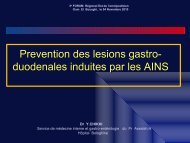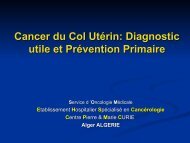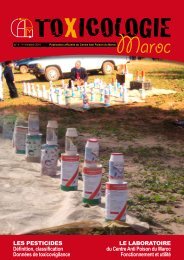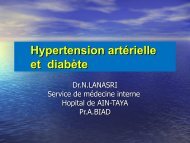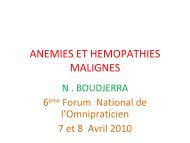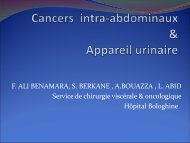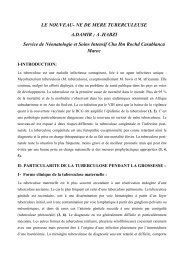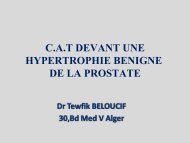Treatment of advanced gastric cancer
Treatment of advanced gastric cancer
Treatment of advanced gastric cancer
You also want an ePaper? Increase the reach of your titles
YUMPU automatically turns print PDFs into web optimized ePapers that Google loves.
<strong>Treatment</strong> <strong>of</strong> <strong>advanced</strong> <strong>gastric</strong> <strong>cancer</strong><br />
Gastrectomy with D2 lymphadenectomy: a review<br />
M.MAAOUI (HOSPITAL BACHIR MENTOURI - ALGIERS)<br />
Radical gastrectomy with regional lymphadenectomy is the mainstay <strong>of</strong> curative<br />
treatment for <strong>advanced</strong> <strong>gastric</strong> <strong>cancer</strong> that has penetrated the submucosa: the<br />
depth <strong>of</strong> invasion (i.e extension into the muscularis propria) has been used to divide<br />
<strong>gastric</strong> carcinoma in early and <strong>advanced</strong> stages (1).<br />
The procedure can be undertaken in the context <strong>of</strong> total or subtotal gastrectomy<br />
where D2 lymphadenectomy indicates nodal dissection to the N2 level.<br />
This has been the standard treatment for <strong>advanced</strong> <strong>gastric</strong> carcinoma in Japan<br />
since the sixties (2, 3, 4, and 5).<br />
The majority <strong>of</strong> patients in the western countries, in South America, in Africa, in<br />
Middle East present <strong>advanced</strong> stages and the majority <strong>of</strong> patients who undergo<br />
gastrectomy are found to have metastatic nodal involvement ( 6In the meantime,<br />
<strong>advanced</strong> but still curable <strong>gastric</strong> <strong>cancer</strong> is associated with very high recurrence<br />
rates, even after R0 gastrectomy (7).<br />
Although the regional lymphadenectomy has been described five decades ago (8)<br />
and widely practiced in Asian and some western institutions with remarkable results, it<br />
still remains controversed in this setting.<br />
At first, the definition <strong>of</strong> D2, which is here the subject <strong>of</strong> our report, is not clearly<br />
defined in the asian or western authors: it is “standard” in these and “extended” in<br />
those.<br />
The rationale in favor <strong>of</strong> D2 lymphadenectomy includes:<br />
- a better regional disease control<br />
- a more appropriate pathologic staging<br />
- an overall improved survival<br />
- with a relapse free survival
- with acceptable hospital mortality<br />
- Without excessive operative morbidity and finally an acceptable quality <strong>of</strong><br />
life.<br />
To realize these objectives, a rigorous pre-operative staging is mandatory: all<br />
classifications find use for TNM: T for tumor, N for lymph node and M for metastasis.<br />
To evaluate these parameters, we have:<br />
• endoscopy and biopsy<br />
• imaging techniques such CT scan or RMI<br />
• ultrasound endoscopy<br />
• Pet scan wich evaluate more or less accurately T and M but fails to give an<br />
idea about the lymph node status (N).<br />
For T, we have location, size, depth, and histology which indicate total or<br />
subtotal gastrectomy if there is no metastases (M0).<br />
The type <strong>of</strong> resection, total or subtotal, is selected according to the location <strong>of</strong> the<br />
tumor: if the proximal margin <strong>of</strong> the tumor is proximal to the line between DEMEL’s<br />
point on the greater curvature and the point 5cm below the cardia on the lesser<br />
curvature, total gastrectomy is indicated.<br />
Furthermore, a total gastrectomy is required irrespective <strong>of</strong> the tumor, in cases <strong>of</strong><br />
BORREMANN type 4 <strong>cancer</strong> or if there is obvious lymph node metastasis at the right<br />
cardial region; otherwise, a distal subtotal gastrectomy is performed (9.10)
What kind <strong>of</strong> lymphadenectomy?<br />
“ Surgery <strong>of</strong> malignant disease is not the surgery <strong>of</strong> organs, it is an<br />
anatomy <strong>of</strong> the lymphatic system” Moyhann said.<br />
Some authors agree with the philosophy and the concept <strong>of</strong> extended lymph<br />
nose dissection was developed five decades ago, and there are claims<br />
based on historical data that the extended surgical resection, especially<br />
extended lymph node dissection, improves the outcome in <strong>gastric</strong> <strong>cancer</strong> (2,<br />
3, 5) with results challenging every competition.<br />
Numerous Japanese publications report about hundred and hundred<br />
gastrectomies an average <strong>of</strong> mortality less than 1%, an acceptable morbidity<br />
<strong>of</strong> 20% and an overall five years survival <strong>of</strong> 50 to 70%!<br />
For instance, SANO et al (11) reported in 2002 one thousand consecutive<br />
gastrectomies without operative mortality!<br />
Such results led to a western reaction: the opponents to the Moyham’s<br />
philosophy in western countries claimed that:<br />
- Japanese authors are confirmed liars (12)<br />
- Japanese are thinner than western patients:<br />
that’s not always true (13) but a medical report (14) and a recent Japanese<br />
randomized trial
( 15) confirm effectively that Body Mass Index is a prognostic factor for the<br />
success <strong>of</strong> lymph node dissection and predicts the outcome <strong>of</strong> <strong>gastric</strong><br />
carcinoma patients.<br />
- Japanese patients are younger: it is true and Nishi (16) found in<br />
Japan an average <strong>of</strong> 10 years less that <strong>of</strong> western countries.<br />
- The <strong>gastric</strong> carcinomas are more frequently located in the distal third than in<br />
the proximal third in the Japanese patients in opposition at that observed in<br />
western countries: surgery would than be easier in these cases.<br />
It is true for the location (17) but we have to emphasize that there is no<br />
meaningful difference between total or subtotal gastrectomy with regard to<br />
prognostic factor (18).
- Japanese <strong>gastric</strong> carcinoma would be biologically different, less aggressive<br />
than in Western countries (19, 20, 21)<br />
- This stingy hypothesis merit no comments.<br />
- Earlier <strong>cancer</strong>, with better prognosis, are more frequent in Japan: it is true<br />
and we have only to congratulate Japanese doctors for these good results<br />
scheduled in a serious health program.<br />
- Japanese reports are retrospective and then, the are not scientifically valid:<br />
according to the recent movement <strong>of</strong> “evidence based medicine” ( 22)<br />
randomized clinical trials ( RCTs) are the best methods <strong>of</strong> effectiveness and<br />
appropriateness <strong>of</strong> treatment.<br />
So the European opponents performed two RCTs ( 23, 34) which were conducted<br />
following the criteria and the procedure established by the Japanese and<br />
comparing D1 versus D2.<br />
The Dutch trial gathered 771 patients operated on in 80 institutions over 4 years:<br />
the morbidity rate was high (4% for D1 and 10% for D2); so was the morbidity rate<br />
(25% for D1 and 43 for D2). There were no significant difference for the 5 years<br />
survival between D1 (45%) and D2 (43%).
The Medical Research Council (400 patients) showed the same results (24).<br />
The conclusion <strong>of</strong> these two RCTs does not support the routine use <strong>of</strong> D2 lymph<br />
node dissection in patients with <strong>gastric</strong> <strong>cancer</strong>. In the mean time, in Japan, D1<br />
lymphadenectomy dissections are listed as palliative procedure and then a RCT<br />
D1 versus D2 would be considered as unethical.<br />
More over, the two European trials are:<br />
• multicenter studies with too much hospitals and surgeons concerned<br />
• these surgeons are <strong>of</strong>ten unfamiliar with the Japanese procedure: even they<br />
had a Japanese supervisor, one could not learn a new technique in a book or<br />
in a videotape. Some <strong>of</strong> these surgeons performed only 2 gastrectomies/<br />
year! (25).<br />
There is also a quality control problem:<br />
It is true that “by working with the Japanese expert at the operation table, many<br />
surgeons, including all the regional consulting surgeons, were able to learn the<br />
new surgical skills in the best way to teach a meticulous or complicated<br />
technique with which most surgeons were previously unfamiliar, and is far more<br />
instructive than reading about or watching” (1).<br />
Despite these respectable speeches, we have to deplore 51% <strong>of</strong> protocol<br />
violation in the Dutch trial! (23).<br />
So, this failure is linked to the inexperience <strong>of</strong> the participating surgeons <strong>of</strong> the<br />
trials.<br />
Their respective learning curve is far from the Japanese or the Asian in general.<br />
For instance, in a recent Korean trial (26), 2 juniors staff surgeons had completed<br />
a two fellowship course on <strong>gastric</strong> <strong>cancer</strong> surgery in university hospital: during this<br />
period each surgeon initially performed <strong>gastric</strong> <strong>cancer</strong> surgeries as an assistant<br />
for more than 200 annually.
Surgeon A performed 102, while surgeon B performed 96 total <strong>gastric</strong> resection<br />
with D2 lymphadenectomy.<br />
The learning period for total gastrectomy with D2 lymph node dissection for these<br />
two juniors members <strong>of</strong> staff was calculated as 23-35 cases, presuming a 92.5%<br />
success rate (i.e reviewed lymph node number cut <strong>of</strong>f value required for<br />
satisfactory D2 lymph node dissection was defined as > 25).<br />
It was observed no death and 25 complications for the 198 patients ( 12.6%).<br />
When we compare with the European RCTs, the difference is overwhelming.<br />
In the Mc Donald’s recent chemoradiation trial (27), more than 54% had D0<br />
resection and only 10% a D2 resection!<br />
In the dutch trial, the proportion <strong>of</strong> non compliance ( patients who did not<br />
complete D2 lymph node dissection) was 51%.<br />
Conversely, the contamination (dissection <strong>of</strong> lymph node outside the indicated<br />
area) blurring thereby the distinction between the two procedure being<br />
compared.<br />
The number <strong>of</strong> reviewed lymph nodes reflects the performance <strong>of</strong> an institution<br />
and its surgeons and pathologists: thus, the pathologist learning curve should be<br />
considered together with that <strong>of</strong> surgeons.<br />
So, quality control is one <strong>of</strong> the most important factor in both surgical and clinical<br />
trials for patients who undergo surgery (1, 28).<br />
Moreover, in the british and dutch trials (23, 24), splenectomy with or without distal<br />
pancreatectomy was highlighted as a major risk factor for operative morbidity<br />
and mortality.<br />
Cushieri et al’s evaluation <strong>of</strong> the 100 patients randomized to a D1 or D2<br />
lymphadenectomy found a significant survival difference between patients with<br />
gastrectomy alone compared with to those with gastrectomy and splenectomy<br />
or pancreatosplenectomy, regardless <strong>of</strong> the extent <strong>of</strong> lymphadenectomy.
Splenectomy for the purpose <strong>of</strong> lymph node dissection should not be mandatory,<br />
and surgeons should consider spleen preservation in <strong>gastric</strong> <strong>cancer</strong> patients who<br />
have no definite splenic hilar lymph node enlargement or any direct invasion <strong>of</strong><br />
the spleen.<br />
Taking into account these recommandations (essentially sparing spleen and<br />
pancreas/gastrectomy with D2 lymph node dissection) is a safe procedure and<br />
actually numerous western single institutions have adopted these procedure,<br />
sometimes reported in non randomized studies (29, 33) or in a randomized clinical<br />
trials (34).<br />
The incidence <strong>of</strong> complications observed in centers specializing in this surgical<br />
procedure has proven to be low: generally it is only slightly higher than reported<br />
by Japanese authors.<br />
The first Japanese RCT initiated by Takeshi Sano and colleagues compared D2<br />
versus D3 lymphadenectomy (35). One <strong>of</strong> their conclusion is that D2 lymph node<br />
dissection is safe and worthwhile.<br />
Moreover, the late results <strong>of</strong> the Dutch trial (36) are less dismal than previously<br />
and the results suggest a better survival after D2 lymph node dissection in N2<br />
patients: that should be a good idea to stratify the patients in controlled trials<br />
because the best way to eliminate stage migration is by comparing long term<br />
survival among all patients who had a D1 or D2 dissection with curative intent.<br />
Precisely, the opponents <strong>of</strong> D2 lymph node dissection argue that this one improve<br />
the staging and not the survival. The consequence the so called “Will Rogers<br />
phenomenon” in which stage migration may improve stage specific survival<br />
regardless <strong>of</strong> a real survival benefit (37).<br />
Concerning classification, there are 2 main classifications:<br />
- the current main classification systems for <strong>gastric</strong> <strong>cancer</strong> are the sixth edition<br />
<strong>of</strong> the UICC/TNM classification (2002 – 38)<br />
- and the thirteenth edition <strong>of</strong> the Japanese classification <strong>of</strong> <strong>gastric</strong> carcinoma<br />
( second English classification 1998 – 39).<br />
Staging has a variety <strong>of</strong> purposes:<br />
- indication <strong>of</strong> prognosis<br />
- ideally it should be able to provide a framework from treatment decision
- and also it should allow evaluation <strong>of</strong> the treatment with meaningful<br />
comparisons between different treatments.<br />
The UIUC/TNM staging system divides N stage on the basis <strong>of</strong> number <strong>of</strong><br />
metastatic nodes, while the Japanese classification stresses the location <strong>of</strong><br />
invaded nodes.<br />
The UIUC and AJCC reached complete agreement that the cut <strong>of</strong>f points for the<br />
N classification should be as follow:<br />
PN1: 1-6 involved regional lymph nodes<br />
PN2: 7-15 involved regional lymph nodes<br />
PN3: more than 15 involved regional lymph nodes.<br />
A minimum <strong>of</strong> 15 lymph nodes should be examined to determine whether a<br />
patient is N0.<br />
TNM classification, 5th edition; 199 7<br />
N1, 1–6 involved nodes; N2, 7–15 involved nodes; N3, _15 nodes<br />
The Japanese <strong>gastric</strong> classification: in its 13 th edition, the general rules changed from<br />
the S stage to the T stage system, which was equivalent to the T staging <strong>of</strong> the UICC<br />
system. The JCGA gives a number to all <strong>of</strong> regional lymphnode station ( 1 to 16),<br />
which are classified in 3 tiers according to the location <strong>of</strong> the primary tumor. These<br />
stations are further classified into N /N /N according to the location <strong>of</strong> the primary<br />
₁ ₂ ₃<br />
tumor. There were a variety <strong>of</strong> changes in this classification such as rules <strong>of</strong>
endoscopic mucosal resection (EMR) and for staging carcinoma <strong>of</strong> the remnant<br />
stomach, and peritoneal cytology has been included in staging (40).<br />
Japanese classification, 13th edition; 1999 (2nd English edition; 1998)<br />
In the western world institutions, the anatomical localization <strong>of</strong> lymph node is<br />
determined by pathologist on the basis <strong>of</strong> formalin fixed “en bloc” resected<br />
specimen and compliance <strong>of</strong> these staging systems has been low.<br />
TNM system (UICC/AJCC) has greater prognostic power than the Japanese<br />
classification: it is essentially post operative staging.<br />
Japanese classification has been designed as a comprehensive guide to treatment,<br />
originally for surgeons and pathologists and today for oncologists and endoscopists<br />
as well.<br />
It is chiefly a pre and per operative staging.<br />
New attempts are performed to improve these performances:<br />
- the ratio metastatic lymph node (RML) is a ratio between positive and<br />
removed nodes: it constitutes for some authors “the most independent<br />
prognostic factor in patients with an R ₀ resection ( 41- 46).<br />
- For these authors,the ratio <strong>of</strong> lymph nodes metastases could be the best<br />
criteria for deciding on accurate lymph node dissection and the regimen for<br />
adjuvant therapy.<br />
- At least, it should be observed that Maruyama index <strong>of</strong> unresected disease or<br />
Maruyama index (MI) allows to estimate the percentage likelihood <strong>of</strong> nodal<br />
involvement for each regional lymph node station( 1.12) left in situ per<br />
patient’s surgeon thanks to a computer program. For the benefit <strong>of</strong> those<br />
unfamiliar with this tool, the Maruyama computer program simply watches a<br />
given case with other similar cases previously treated at the national <strong>cancer</strong><br />
center in Tokyo.<br />
- The large number <strong>of</strong> cases in the NCC Tokyo database (daily expanded)<br />
serves to make the model predictions <strong>of</strong> this computer program highly
accurate, not only for Japanese cases but those from Germany and Italy as<br />
well (47).<br />
- All <strong>of</strong> these staging systems have a purpose among others to choose those <strong>of</strong><br />
patients who are fit for adjuvant therapy.<br />
This is an exciting perspective as showed by Mc Donald Trial (27), but one has<br />
to be aware <strong>of</strong> mass risk <strong>of</strong> surgical undertreatment, because <strong>of</strong> the excessive<br />
rely upon chemoradiotherapy to cure the <strong>gastric</strong> <strong>cancer</strong>: in the Mc Donald’s<br />
trial, 54% <strong>of</strong> patients had D ₀: it is incredible.<br />
On the whole, performing a correct gatrectomy with D ₂ lymph nodes<br />
resection dictates some operative skills and intensive post operative care.<br />
- With a pathologist inclined to perform largely histopathologic examination <strong>of</strong><br />
all the harvested lymph nodes.<br />
- Attempting the most rigorous staging possible.<br />
- In specialized institutions (High volume hospital).<br />
- This D ₂ lymphadenectomy should avoid splenopancreatectomy if neither<br />
spleen nor the pancreas is involved or concerned by the tumor.<br />
For this purpose it has been proposed a technical refinement: the so called<br />
over D ₁ or D1.5 dissection (Furukawa 48).<br />
- We have also to initiate large randomized clinical trials with subgroups<br />
stratifications in order to minimize the possibility <strong>of</strong> stage migration due to<br />
larger LN numbers examined by selecting the highest nodal stage category<br />
(N ₃) (49).<br />
Perspectives:<br />
- Tools as sentinel lymph node biopsy are currently being developed to identify<br />
patients with high risk <strong>of</strong> lymph node metastases which could influence the<br />
extent <strong>of</strong> surgery(50)<br />
- Genomic pr<strong>of</strong>iling <strong>of</strong> <strong>gastric</strong> adenocarcinoma using microassay analysis <strong>of</strong><br />
chromosomal copy number which also seems to be a promising<br />
developpement enabling more tailored treatment. (51).<br />
Conclusions:<br />
Where are we?<br />
When we consider the Japanese guidelines (52)
, D gatrectomy is clearly defined as standard surgery for <strong>advanced</strong> <strong>gastric</strong><br />
₂<br />
<strong>cancer</strong> while the British <strong>cancer</strong> guidance discourages D , based on the poor<br />
₂<br />
results <strong>of</strong> the two western RCTs (53).
References<br />
1- SASAKO,M; Maruyama, k; KINOSHITA, T; BONENKAMP, J; Van de Velde, CJH; Hermans,<br />
J « A multicenter prospective, randomized controlled study on the surgical treatment<br />
<strong>of</strong> <strong>gastric</strong> <strong>cancer</strong> » JPn J Clin Oncol 1992-2 (1): 41-48<br />
2- Kajitani,T Japanese Research society for <strong>gastric</strong> <strong>cancer</strong>. “The general rules for the<br />
<strong>gastric</strong> <strong>cancer</strong> study in surgery and pathology” Part I. Clinical classification.<br />
JPN.J.Surg 1981.11: 127-39<br />
3- NOGUCHI, Y; Imada, T; MATSUMOTO, A; COIT, DG; BRENNAN, M Radical surgery for<br />
<strong>gastric</strong> <strong>cancer</strong> : a review <strong>of</strong> the Japanese experience . Cancer 1989 64: 2053-62<br />
4- Maruyama, K; Okabayashi, K; Kinoshita, T Progress in <strong>gastric</strong> <strong>cancer</strong> surgery in Japan<br />
and its limits <strong>of</strong> radicality. World.J.Surg 1987: 11: 418-426<br />
5- Maruyama, K; SASAKO, M; KINOSHITA, T et al « Should systematic lymph node<br />
dissection be recommanded for <strong>gastric</strong> <strong>cancer</strong> ? » Eur.J.Cancer 1998- 34: 1480-9<br />
6- FUCHS, CS; Mayer, RJ Gastric carcinoma.New Engl.J.med 1995 – 333: 32-41<br />
7- Roukos, DH Current status and future perspectives i n <strong>gastric</strong> <strong>cancer</strong> management.<br />
Cancer Treat Rev 2000. 26: 243-55
8- Mc Neer, G; Lawrence, W; Ortefa, LG; Sunderland, DA Early results <strong>of</strong> extended total<br />
gastrectomy for <strong>cancer</strong>. Cancer 1956- 9: 1153-9<br />
9- Piso, P; Werner, U; Lang, H et al Proximal versus distal <strong>gastric</strong> carcinoma- what are the<br />
differences. Annals <strong>of</strong> Surgical Oncology 2000 – 7 (1): 520-5<br />
10- Harrison, LE; Karpeh, MS; Brinnam, ME Total gastrectomy is not necessary for proximal<br />
<strong>gastric</strong> <strong>cancer</strong>.Surgery 1998; 19: 523-31<br />
11- Sano, T; KATAI, H; SASAKO, M et al One thousand consecutive gastrectomies without<br />
operative mortality. Br.J.Surg . 2002- 89: 123<br />
12- Alan GK, li “ An overseas perspective <strong>of</strong> evolving <strong>gastric</strong> <strong>cancer</strong> practices in japan”<br />
Japanese Journal <strong>of</strong> clinical oncology. 2005- 35 (3): 165-167<br />
13- RAMIREZ, MP The myth <strong>of</strong> thin patients as explanation for the excellent results <strong>of</strong> the<br />
Japanese technique in the surgical treatment <strong>of</strong> <strong>gastric</strong> <strong>cancer</strong>. JPN J Clin Oncol<br />
2006- 36 (1) : 64<br />
14- DHAR, DK; Kubota, H; Tachibana, M et al Body mass index determines the success <strong>of</strong><br />
lymph node dissection and predicts the outcome <strong>of</strong> <strong>gastric</strong> carcinoma<br />
patients.Oncology 2 000: 59(1): 18- 23<br />
15- TANAKA, T; Nagata, C; OBA, S et al Prospective cohort study <strong>of</strong> Body Mass Index in<br />
adolescence and death from stomach <strong>cancer</strong> in Japan Cancer Sci: 2007- 98 ( 11):<br />
1785-9<br />
16- Nishi, M; Ichikawa, H; Nakajima, T; Maruyama, K; TAHARA, E Gastric <strong>cancer</strong>. Springer-<br />
Verlag- Tokyo- Berlin- Heidelberg 1993: 319- 330<br />
17- Blot WJ; Devesa, SS; Kneller, RW et al “ Rising incidence <strong>of</strong> adenocarcinoma <strong>of</strong> the<br />
oesophagus and <strong>gastric</strong> cardia.” Jama 1991- 265: 1287- 89
18- Maruyama, K Surgical treatment and end results <strong>of</strong> <strong>gastric</strong> <strong>cancer</strong>. Tokyo national<br />
<strong>cancer</strong> center 1985<br />
19- Fielding, JWL Gastric <strong>cancer</strong>: different diseases.Br J Surg 1989: 76: 1227<br />
20- ADAM, YG; Efron, E “ TRENDS and controversies in the management <strong>of</strong> carcinoma <strong>of</strong><br />
the stomach”. Surg.Gyn.obs.1989: 169: 371- 385<br />
21- Schwartz, RE; Zagala- Nevarez, K “ Ethnic survival differences after gastrectomy for<br />
<strong>gastric</strong> <strong>cancer</strong> are better explained by factors specific for disease location and<br />
individual patient comorbidity”. Eur.J.Surg.Oncol.2002; 29 (3): 214-19<br />
22- Sackett, D; Rosenberg WMC; Gray Jam; Haynes RB; Richardson, WS Evidence based<br />
medicine: what it is and what isn’t? BMJ.1996: 312- 71<br />
23- Bonenkamp, JJ; Hermans, J; Sasako, M; Van de Velde, CJH ( Dutch <strong>gastric</strong> <strong>cancer</strong><br />
group) Extended lymph node dissection for <strong>gastric</strong> <strong>cancer</strong>. New.Eng.J.med 1999: 340:<br />
908- 14<br />
24- Cushieri, A; Weeden, S; Fielding, J et al Medical research council “ Patients survival<br />
after D ₁ and D ₂ resections for <strong>gastric</strong> <strong>cancer</strong>: long term results <strong>of</strong> the MRC<br />
randomized surgical trial. Surgical co-operative group”. Br.J.Cancer 1999: 79: 1522- 30<br />
25- Brennan, MF Lymph node dissection for <strong>gastric</strong> <strong>cancer</strong>.The New. Engl.J.med. 1999:<br />
340: 956-958<br />
26- JUN.HO.LEE “Learning curve for total gastresctomy with D lymph node dissection:<br />
₂<br />
cumulative sum analysis for qualified surgery”.Annals <strong>of</strong> surgical oncology 2006.13 ( 9)<br />
1175-1181
27- Mc Donald, JS; Smalley, SR; Benedetti, J et al Chemoradiotherapy after surgery alone<br />
for adenocarcinome <strong>of</strong> the stomach on gastro-oesophageal junction.N.Engl.J.med<br />
2001: 345- 30<br />
28- Warren, WD Controlled clinical research opportunities and problems for the surgeon<br />
(presidential address to the society for surgery <strong>of</strong> the alimentary tract 1973) Am J Surg<br />
1990 160: 4-8<br />
29- Roukos, DH; Lorenz, M; Encke, A Evidence <strong>of</strong> survival benefit <strong>of</strong> extended<br />
lymphadenectomy in western <strong>gastric</strong> <strong>cancer</strong> patients based on a new concept. A<br />
prospective long term follow up study. Surgery 1998- 123: 573-8<br />
30- Siewert, JR; Boettcher, K; Stein, HJ et al Relevant prognostic factors in <strong>gastric</strong> <strong>cancer</strong>.<br />
Ten year results <strong>of</strong> the german <strong>gastric</strong> <strong>cancer</strong> study. Ann Surg 1998.228: 449-61<br />
31- Roviello, F; Marelli, PM; De Manzenni, G Survival benefit <strong>of</strong> extended D₂<br />
lymphadenectomy in <strong>gastric</strong> <strong>cancer</strong> with involvement <strong>of</strong> second level lymph nodes:<br />
a longitudinal multicenter study. Annals <strong>of</strong> surgical oncology 2002.9: 894-900<br />
32- Volpe, CM; Koo, J; Miloro, SM et al The effect <strong>of</strong> extended lymphadenectomy on<br />
survival in patients with <strong>gastric</strong> adenocarcinoma. J.am.coll.surg 1995 181: 56- 64<br />
33- Bozzetti, F; Marubini, E; Bontant, G et al Subtotal versus total gastrectomy for <strong>gastric</strong><br />
<strong>cancer</strong> : a five survival rate in a multicenter randomized Italian trial- Italian gastrointestinal<br />
tumor study group.Ann Surg 1999 230: 170-178<br />
34- Degiuli, M; Sasako M; Pouti, A et al Morbidity and mortality after D ₂ gastrectomy for<br />
<strong>gastric</strong> <strong>cancer</strong> results <strong>of</strong> the Italian <strong>gastric</strong> study group prospective multicenter<br />
surgical study.J.Clin oncol 1998 16 1490- 1493<br />
35- Sano, J; Sasako, M; Yamamoto, S et al “ Gastric <strong>cancer</strong> surgery: morbidity and<br />
mortality results from a prospective randomized controlled trial comparing D and ₂<br />
extended paraaortic lymphadenectomy” Japan clinical oncology group study 9501.<br />
Journal <strong>of</strong> clinical oncology 2004 22 ( 14): 2767- 73
36- Hartgrink, HH; Van de Velde, CJH; PUTTER, H et al Extended lymph node dissection for<br />
<strong>gastric</strong> <strong>cancer</strong>: who may benefit? Final results <strong>of</strong> the randomized dutch <strong>gastric</strong><br />
<strong>cancer</strong> group trial. Journal <strong>of</strong> clinical oncology 2004 22 ( 11): 2069-2077<br />
37- Feinstein, AR; Sosin, DM; Wells CK The Will Rogers phenomenon. Satge migration and<br />
new diagnostic techniques as a source <strong>of</strong> misleading statistics for survival in <strong>cancer</strong>.<br />
N.Engl.J.med 1985: 312: 1604-8<br />
38- Sobin L; Wittekingch.editors TNM classification <strong>of</strong> malignant tumors – 6 th Ed.New York:<br />
Wiley-liss; 2002<br />
39- Aiko, T; Sasako, M The new Japanese classification <strong>of</strong> <strong>gastric</strong> carcinoma: points to be<br />
revised. Gastric <strong>cancer</strong> 1998 – 1: 25- 30<br />
40- Sayegh, ME; Sano, T; Dexter, S; Katai, H; Fukagawa, T; Sasako, M TNM and Japanese<br />
staging systems for <strong>gastric</strong> <strong>cancer</strong>: how do they coexist? Gastric <strong>cancer</strong> 2004: 7: 140-<br />
148<br />
41- Sasako, M; Mc Culloch, P; Kinoshita, T New method to evaluate the therapeutic value<br />
<strong>of</strong> lymph node dissection for <strong>gastric</strong> <strong>cancer</strong>. Br.J.Surg 1995: 82: 346-51<br />
42- Siewert, TA; Böhcher, K; Stein, HJ et al German <strong>gastric</strong> carcinoma study group.<br />
Relevant prognostic factors in <strong>gastric</strong> <strong>cancer</strong>: ten years results <strong>of</strong> the German <strong>gastric</strong><br />
<strong>cancer</strong> study. Ann Surg 1998 – 228: 449- 61<br />
43- YU, W; Choi, GS; Whang, I Comparison <strong>of</strong> five systems for staging lymph node<br />
metastasis in <strong>gastric</strong> <strong>cancer</strong>.Br J. Surg 1997 84: 1305- 9<br />
44- NITTI, D; Marchet, A; Olivieri, M et al Ratio between metastatic and examined lymph<br />
nodes is an independant prognostic factor after D ₂ resection for <strong>gastric</strong> <strong>cancer</strong>:<br />
analysis <strong>of</strong> a large European monoinstitutional experience. Annals <strong>of</strong> surgical<br />
oncology 2003- 10: 1077-85<br />
45- Kodera, Y; Schwartz, RE; Nakao, A Extended lymph node dissection in <strong>gastric</strong><br />
carcinoma: where do we stand after the Dutch and British randomized trials?<br />
J.am.coll.surg 2002: 195 (6) : 855-64
46- Bando, E; Yonemura, Y; Taniguchi, k et al « Outcome <strong>of</strong> ratio <strong>of</strong> lymph node<br />
metastasis in <strong>gastric</strong> carcinoma » Annals <strong>of</strong> surgical oncology 2002: 9: 775- 84<br />
47- Kampschoer, G; Maruyama, K; Van de Velde, CJH et al Computer analysis in making<br />
preoperative decisions : a rational approach to lymph node dissection in <strong>gastric</strong><br />
<strong>cancer</strong> patients. Br J Surg 1989- 76: 905- 8<br />
48- Furukawa, H; Hiratsuka, M; Ishikawa, O et al Total gastrectomy with dissection <strong>of</strong><br />
lymph nodes along the splenic artery: a pancreas preserving method. Annals <strong>of</strong><br />
surgical oncology 2000<br />
49- Schwartz, RE; Smith, D Clinical impact <strong>of</strong> lymphadenectomy extent in resectable<br />
<strong>gastric</strong> <strong>cancer</strong> <strong>of</strong> <strong>advanced</strong> age. Annals <strong>of</strong> surgical oncology 2006 (14/2): 317- 328<br />
50- Van de Velde, CJH; PEETERS, KCMJ The <strong>gastric</strong> <strong>cancer</strong> treatment controversy.<br />
Journal <strong>of</strong> Clinical Oncology 2003- 21 (12): 2234-6<br />
51- Weiss, M “ Genomic pr<strong>of</strong>iling <strong>of</strong> <strong>gastric</strong> <strong>cancer</strong> predicts lymph node status and<br />
survival”. Oncogene 2003 22: 1872- 73<br />
52- Nakajima, T Gastric <strong>cancer</strong> treatment guidelines in Japan. Gastric <strong>cancer</strong> 2002 5: 1- 5<br />
53- Allum, WH; Griffin, SM; Watson, A; Colin-Jones, D On behalf <strong>of</strong> the Association <strong>of</strong><br />
Upper gastro-intestinal surgeons <strong>of</strong> Great Britain and Ireland, the british society <strong>of</strong> !<br />
gastro-enterology and the br€itish Association <strong>of</strong> surgical oncology. Guidelines for the<br />
management <strong>of</strong> oesophageal and <strong>gastric</strong> <strong>cancer</strong>.Gut<br />
This paper has been presented in:
International Digestive Cancer Alliance*<br />
African Middle East Association <strong>of</strong> Gastroenterology<br />
WGO Training Center Rabat<br />
1 st Summer Postgraduate Course on Digestive Oncology<br />
“21 st Century Tools for Managing Liver and Stomach Cancer”<br />
Rabat 14 & 15 June 2007<br />
Dr Tayebi has participated in the page-setting <strong>of</strong> this document.




